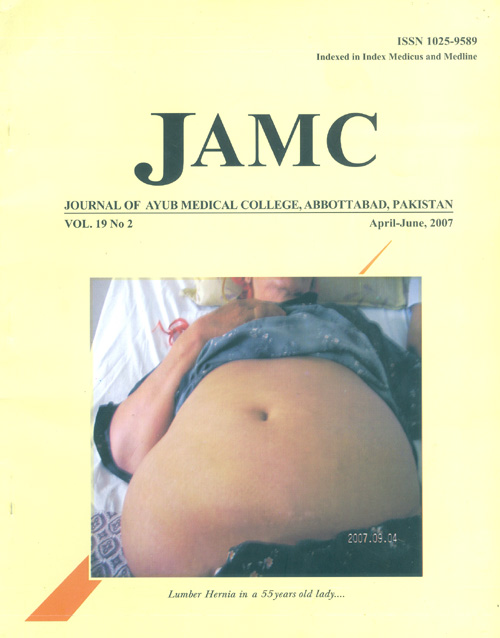PATTERN OF MALARIAL INFECTION DIAGNOSED AT AYUB TEACHING HOSPITAL ABBOTTABAD
Abstract
Background: Malaria is endemic in Abbottabad and the adjoining areas like many other parts ofthe country. Depending upon the environmental conditions different species of malarial parasiteare found in different areas. The present study was planned to see the pattern of malarial infectiondiagnosed at Ayub Teaching Hospital, Abbottabad. Methods: Giemsa stained thick and thin bloodfilms of indoor and outdoor febrile patients sent to the laboratory of Ayub Teaching HospitalAbbottabad with a suspicion of malaria, were examined. Thick film was examined for thediagnosis of malaria while thin films were seen to know the species. Results: Out of 1994 patientsscreened, 145 (7.2%) were found infected. Plasmodium vivax was seen in the majority(72.47.2%). Plasmodium falciparum was the second common species detected in 24.1 % cases.Mixed infection was seen in 3.44% cases while Plasmodium malariae and ovale was not seen inany patient. Conclusion: Plasmodium vivax was the commonest type of malaria diagnosed atAyub Teaching Hospital, Abbottabad, during 2002- 2004.Key words: Malaria; PlasmodiumReferences
Muentener P, Schlagenhauf P, Steffen R. Imported malaria
(1985–95): trends and perspectives. Bull World Health
Organ 1999; 77:560-6.
Sachs J, Malaney P. The economic and social burden of
malaria. Nature. 2002; 415:680-5.
Trampuz A, Jereb M, Muzlovic L, Prabhu RM. Clinical
review: Severe malaria. Crit Care 2003;7(4):315-23
Jan AH, Kiani TA. Haematozoan parasites in Kashmiri
refugees. Pakistan J Med Res 2001; 40(1): 10-2.
Moody AH, Chiodini PL. Methods for the detection of blood
parasites. Clin Lab Haematol 2000; 22(4):189-201
Jamal MM, Ara J, Ali N. Malaria in pediatric age group: a
study of 200 cases. Pak Armed Forces Med J 2005; 55(1):74-
Haider I, Qazi SA. Malaria in neonates. Pak Paed J
;19(2):81-2.
Mahmood T, Maqbool S, Mahmood R. Malaria as a cause of
acute fever without localizing signs (AFWLS) in children.
Pak Paed J 1999;23(1):9-11.
Zaman V, Beg A. Laboratory diagnosis of Malaria. Infect
Dis J 2004; 13(2):47-8.
Rahim F, Younas M. Malaria in children : clinical profile and
response to treatment. A district level experience. J Med Sci
;11(1):21-5.
Muhammad AK, Smego RA, Razi ST, Muhammad AB.
Emerging drug resistance and guidelines for treatment of
malaria. J Coll Physicians Surg Pak 2004;14(5):319-24.
Arain A, Shaikh S, Shaikh A. Study of malaria in children at
Liaquat Medical College Hospital. Pak Paed J 1997;21(2):
-7.
Ghulam M, Memon IA, Noorani AK. Malaria prevalence in
Sindh. Med Channel 2004;10(2):41-2.
Khan Z, Shoaib S, Ahmed TM, Maqbool S, Isani Z,
Mehmood K et al. Efficacy and safety of halofantrine
hydrochloride in malaria treatment. J Pak Inst Med Sci
;15(1):853-6.
Muhammad N, Hussain A. Prevalence of Malaria in general
population of district Buner. J Postgrad Med
Inst2003;17(1):75-80.
Issue
Section
License
Journal of Ayub Medical College, Abbottabad is an OPEN ACCESS JOURNAL which means that all content is FREELY available without charge to all users whether registered with the journal or not. The work published by J Ayub Med Coll Abbottabad is licensed and distributed under the creative commons License CC BY ND Attribution-NoDerivs. Material printed in this journal is OPEN to access, and are FREE for use in academic and research work with proper citation. J Ayub Med Coll Abbottabad accepts only original material for publication with the understanding that except for abstracts, no part of the data has been published or will be submitted for publication elsewhere before appearing in J Ayub Med Coll Abbottabad. The Editorial Board of J Ayub Med Coll Abbottabad makes every effort to ensure the accuracy and authenticity of material printed in J Ayub Med Coll Abbottabad. However, conclusions and statements expressed are views of the authors and do not reflect the opinion/policy of J Ayub Med Coll Abbottabad or the Editorial Board.
USERS are allowed to read, download, copy, distribute, print, search, or link to the full texts of the articles, or use them for any other lawful purpose, without asking prior permission from the publisher or the author. This is in accordance with the BOAI definition of open access.
AUTHORS retain the rights of free downloading/unlimited e-print of full text and sharing/disseminating the article without any restriction, by any means including twitter, scholarly collaboration networks such as ResearchGate, Academia.eu, and social media sites such as Twitter, LinkedIn, Google Scholar and any other professional or academic networking site.









